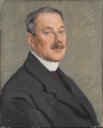Back to top
Ottilie W. Roederstein
Portrait artist, Painter (female), Still-life painter (female) and Landscape artist
- Born
- 1859 in Zurich
- Died
- 1937 in Hofheim am Taunus
22 Works by Ottilie W. Roederstein
- Portrait of a Painter in a Parisian Studio
![Portrait of a Painter in a Parisian Studio, Ottilie W. Roederstein]()
- Portrait of the Painter Jakob Nussbaum
![Portrait of the Painter Jakob Nussbaum, Ottilie W. Roederstein]()
- Self-Portrait with Folded Arms
![Self-Portrait with Folded Arms, Ottilie W. Roederstein]()
- Self-Portrait with Hat
![Self-Portrait with Hat, Ottilie W. Roederstein]()
- Die Bäuerin mit dem Kopftuch
![Die Bäuerin mit dem Kopftuch, Ottilie W. Roederstein]()
- Ergebung
![Ergebung, Ottilie W. Roederstein]()
- Old Woman Reading
![Old Woman Reading, Ottilie W. Roederstein]()
- Portrait of Alexej von Jawlensky
![Portrait of Alexej von Jawlensky, Ottilie W. Roederstein]()
- Portrait of Dr. Elisabeth Winterhalter
![Portrait of Dr. Elisabeth Winterhalter, Ottilie W. Roederstein]()
- Portrait of Dr. Elisabeth Winterhalter
![Portrait of Dr. Elisabeth Winterhalter, Ottilie W. Roederstein]()
- Portrait of Helene Roederstein (The Painter’s Sister)
![Portrait of Helene Roederstein
(The Painter’s Sister), Ottilie W. Roederstein]()
- Portrait of Prof. Herxheimer
![Portrait of Prof. Herxheimer, Ottilie W. Roederstein]()
- Portrait of Reinhard Roederstein (father of the painter)
![Portrait of Reinhard Roederstein (father of the painter), Ottilie W. Roederstein]()
- Portrait of the Concert Singer and Conductor Prof. Julius Stockhausen
![Portrait of the Concert Singer and Conductor Prof. Julius Stockhausen, Ottilie W. Roederstein]()
- Self-portrait with Keys
![Self-portrait with Keys, Ottilie W. Roederstein]()
- Still Life: Basket with Fruit on a Table in front of a Curtain and Wallpaper
![Still Life: Basket with Fruit on a Table in front of a Curtain and Wallpaper, Ottilie W. Roederstein]()
- Still Life with Pears and Casserole
![Still Life with Pears and Casserole, Ottilie W. Roederstein]()
- The Sisters
![The Sisters, Ottilie W. Roederstein]()
- The Victor
![The Victor, Ottilie W. Roederstein]()
- Bildnis Gabriele von Wartensleben
![Bildnis Gabriele von Wartensleben, Ottilie W. Roederstein]()
- Porträtkopf Gräfin von Wartensleben
![Porträtkopf Gräfin von Wartensleben, Ottilie W. Roederstein]()
- Selbst als Autopilotin
![Selbst als Autopilotin, Ottilie W. Roederstein]()
Works displaying Ottilie W. Roederstein
Video
FREI. SCHAFFEND. Die Malerin Ottilie W. Roederstein | STÄDEL MUSEUM
Die deutsch-schweizerische Malerin Ottilie W. Roederstein (1859–1937) zählte zu den erfolgreichsten Künstlerinnen der Zeit um 1900. Das Städel Museum zeigt mit der Ausstellung "FREI. SCHAFFEND. Die Malerin Ottilie W. Roederstein" eine umfassende Retrospektive, die einen Überblick über die künstlerische Entwicklung der stilistisch vielseitigen Malerin gibt. Im Film zur Ausstellung gehen Eva-Maria Höllerer, eine der Kuratoren der Ausstellung, und Dr. Iris Schmeisser, Leiterin Provenienzforschung und historisches Archiv, der Frage nach, was die Malerin so einzigartig macht.
Mehr Informationen zur Ausstellung: https://www.staedelmuseum.de/de/frei-schaffend
Biography
Persons connected to Ottilie W. Roederstein
- Winterhalter, Elisabeth Life companion (female)
- Carolus-Duran, Emile Auguste Teacher (male)
- Gussow, Karl Teacher (male)
- Henner, Jean-Jacques Teacher (male)
- Mannfeld, Bernhard Bekanntschaft
- Merson, Luc Olivier Teacher (male)
- Pfyffer, Eduard Teacher (male)
- Pidoll, Karl von Bekanntschaft
- Battenberg, Mathilde Pupil (female)
- Battenberg, Ugi Pupil (male)
- Bekker vom Rath, Hanna Pupil (female)
- Fleischhauer, Jenny Pupil (female)
- Gans, Clara Pupil (female)
- Guaita, Else von Pupil (female)
- Kowarzik, Pauline Pupil (female)
- Luthmer, Else Friend (female)
- Pinner, Erna Pupil (female)
- Righini, Sigismund Pupil (male)
- Schauroth, Lina von Pupil (female)
- Scheuermann, Julia Virginia Pupil (female)
- Roederstein, Alwina Mother
- Roederstein, Reinhard Father
- Roederstein, Helene Sister
- Voos-Roederstein, Johanna Sister
- Thoma, Hans Friend (male)
- Hoppe, Juliane Model (art)
- Bertuch, Marie Friend (female)
- Breslau, Marie-Louise-Catherine Friend (female)
- Certowicz, Tola Friend (female)
- Edinger, Anna Friend (female)
- Gerhardi, Ida Friend (female)
- Nussbaum, Jakob Friend (male)
- Smith, Jeanne Friend (female)
- Stebler-Hopf, Anny Friend (female)
- Smith, Madeleine Pupil (female)
- Kopp, Emma Pupil (female)
- Lehnert, Hildegard Friend (female)
- Mulnier, Ferdinand Bekanntschaft
- Nourse, Elizabeth Friend (female)
- Amans, Louise Friend (female)
- Amiet, Anna Friend (female)
- Amiet, Cuno Friend (male)
- Roszmann, Augusta Friend (female)
- Boznańska, Olga Friend (female)
- Quarck-Hammerschlag, Meta Bekanntschaft
- Schwabacher, Sascha Bekanntschaft
- Jughenn, Hermann Friend (male)
- Dannenberg, Alice Friend (female)
- Gadesmann, Meta Friend (female)
- Hitz, Dora Friend (female)
- Kerkovius, Ida Friend (female)
- Robbins, Lucy Lee Friend (female)
- Schmidt, Louise Bekanntschaft
- Stettler, Martha Friend (female)
- Trübner, Alice Friend (female)
- Wartensleben, Gabriele von Friend (female)
- Sommer, Martha Friend (female)
- Joeden, Frieda Blanca von Pupil (female)
- Waser, Maria Friend (female)
- Metzler, Wilhelm Peter Bekanntschaft
- Hesse, Hermann Bekanntschaft
- Schäfer, Wilhelm Bekanntschaft
- Tobler, Clara Friend (female)
Groups and institutions Ottilie W. Roederstein belongs to
- Organization of Women Artists Artists' association
- Frankfurt-Cronberger-Künstler-Bund Artists' association
- Reichskammer der Bildenden Künste Artists' association
- Atelier Roederstein-Bertuch (Frankfurt am Main, Hochstraße 40) Atelier
- Atelier Roederstein-Nourse (Paris, rue de la Grande-Chaumière 8) Atelier
- Société nationale des Beaux-Arts Artists' association























